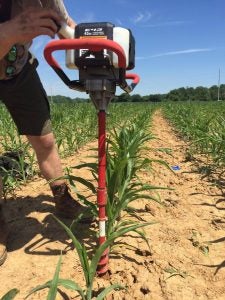Technology and rural life. At first blush, especially to urban residents, the terms don’t seem to go together. But does rural life rely on technology for its continuation?
Rural and agriculture go hand-in-hand. Agriculture, by nature, preserves large tracts of land to produce crop and livestock products, which of course prevents their development into urban and suburban areas. Agriculture industries across the nation are struggling, whether it be due to legislation, commodity markets, weather, or other factors. If agriculture is struggling, then rural life is struggling. Technology is a necessary requirement to support agriculture and maintain the structure of rural life.
New advancements in technology are making farmers and ranchers more profitable, helping solve problems they face, improving the sustainability of agriculture, and thereby protecting the rural lifestyle. Tools like soil moisture sensors, GPS technology in equipment, artificial intelligence, and other precision agriculture tools have allowed farmers and ranchers to produce more products with less resources. Increasing product yield — whether it be a tomato crop, pounds of beef, or gallons of milk– while reducing the physical and financial aspects used to create them helps make farmers more profitable. Since agricultural industries typically aren’t “big money” industries, every additional dollar earned is helping to maintain the operation. Preserving agriculture inherently preserves rural areas.

Many agriculture technology tools developed and utilized today help solve problems that farmers face. The labor pool in ag has become an increasingly difficult factor of production, with many operations not able to hire employees because they either 1) cannot find them or 2) cannot afford them.
Tools such as robotic milkers and calf feeding machines in dairies, mechanical harvesting tools in fruit and vegetable production, and even GPS collars for beef cattle to monitor health have become more commonplace. The dairy industry has struggled for several years, and they seem to be one industry that has easily adopted the use of automatic tools throughout their operations and recognized their benefits.
These tools help reduce the need for employees on the operation and allows current staff to divert time and effort to other tasks. Often there is concern around automation and “robots taking over the world,” but in ag, it seems to have become a necessity for survival. Future steps in ag technology will see a stronger move toward automation — for example, new automatic harvesting machines with artificial intelligence are being debuted by multiple companies recently and work towards driver-less tractors is happening right now.

These tools not only help farmers perform tasks on their operation and increase profitability but also help increase public perception and support of ag industries. Many of the tools mentioned previously help reduce resource use, particularly water and fertilizer. Addressing concerns of environmentally sustainability has helped improve public perception since this hot topic began plaguing ag in the last decade.
Increased use of technological tools in the livestock sector have shown improvements in animal welfare, and hard data is being produced in operations across the U.S. to prove animals are healthy and well cared for. Adoption of technology has made the life of the producer easier, but also confirmed to the public that agriculturalists are committed to providing a safe, healthy food source in the best way possible.
One of the biggest areas of technology that would provide the impact to rural residents is internet access. A reliable internet connection offers many benefits to your life, not only in the areas of leisure like accessing streaming services or social media, but also in your ability to access educational information online, business management tools, and agricultural tech tools related to production.
According to Pew Research Center, only 63 percent of rural residents have at least a broadband internet connection at home, with an additional 24 percent stating that accessing high-speed internet is a major problem in their community.
Lack of access to and use of internet tools in rural areas delay the potential adoption of future technological tools. Work to expand internet access in rural communities will increase the ability of producers to better their operations and maintain the rural lifestyle.
Michelle Miller, the Farm Babe, is a farmer, public speaker and writer who has worked for years with row crops, beef cattle, and sheep. She believes education is key in bridging the gap between farmers and consumers.



